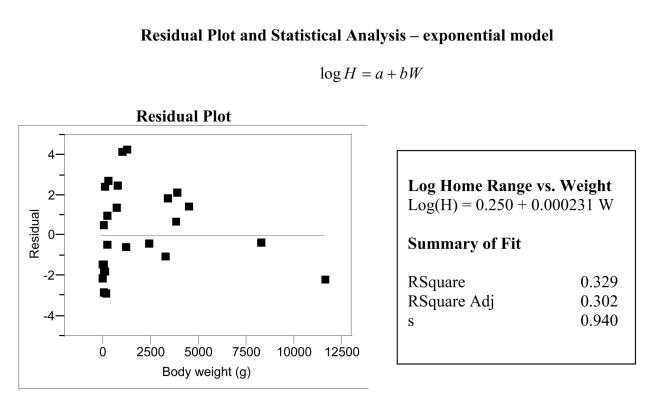Golden-rumped elephant shrews have long flexible snouts, used to overturn leaf-litter where they find their food: millipedes, insects and spiders.These animals are among the approximately 10% of mammalian species that mate for life.Just why these mammals are monogamous is poorly understood, and one theory is that a monogamous male would have to defend less territory from intrusion by other males. The home range of an animal, i.e.that area over which they typically travel, is a function of diet and energy consumption of the animal.The energy consumption is, in turn, typically a function of the animal's size.In a recent study, investigators reasoned that if monogamy was related in some way to the home territory, this should be detectable by comparing these animals to other insect-eating mammals.Data were gathered on 27 similar species and is presented in the table below.  After fitting a straight line model,
After fitting a straight line model,  , significant curvature was detected in the residual plot, and two transformed models were chosen for further analysis: the power and exponential models.The computer output for these transformed models and the residual plots follow on the next page.
, significant curvature was detected in the residual plot, and two transformed models were chosen for further analysis: the power and exponential models.The computer output for these transformed models and the residual plots follow on the next page. 
 a)For the exponential model, calculate the predicted log (Home Range)for a Weight of 1000g. b)Generally speaking, which of the two models, power or exponential, is better at predicting the log (Home Range)? Provide statistical justification for your choice. c)These shrews typically weigh 550g and their home range is about 2.9 hectares.Using your preferred model from part (c), locate the Golden-rumped elephant shrew on the appropriate residual plot by marking with a small "x." Does your placement of this point suggest the monogamy of these shrews sets them apart from similar species? In a few sentences, explain why or why not.
a)For the exponential model, calculate the predicted log (Home Range)for a Weight of 1000g. b)Generally speaking, which of the two models, power or exponential, is better at predicting the log (Home Range)? Provide statistical justification for your choice. c)These shrews typically weigh 550g and their home range is about 2.9 hectares.Using your preferred model from part (c), locate the Golden-rumped elephant shrew on the appropriate residual plot by marking with a small "x." Does your placement of this point suggest the monogamy of these shrews sets them apart from similar species? In a few sentences, explain why or why not.
Correct Answer:
Verified
View Answer
Unlock this answer now
Get Access to more Verified Answers free of charge
Q4: If on average y increases as x
Q8: a)What is the equation of the least
Q9: Suppose that the coins analyzed in problem
Q10: The coefficient of determination is equal to
Q11: In the 19th Century, venereal diseases were
Q12: The standard deviation about the least squares
Q15: If r is close to 1, then
Q16: The least squares line passes through the
Q19: The value of Pearson's r is always
Q20: The slope of the least squares line
Unlock this Answer For Free Now!
View this answer and more for free by performing one of the following actions

Scan the QR code to install the App and get 2 free unlocks

Unlock quizzes for free by uploading documents